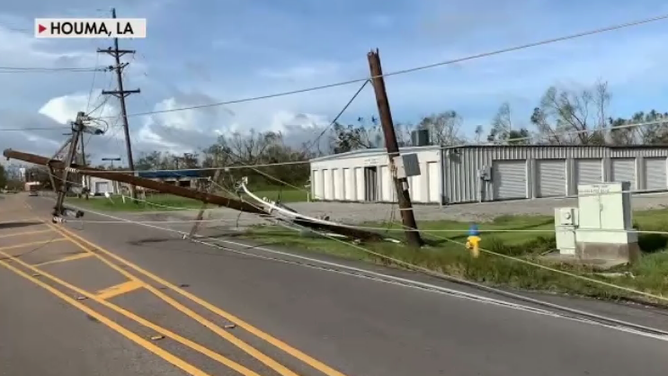Power-ravaged New Orleans now faces days of steamy heat without air conditioning
More than 1 million homes and businesses remain without power in southeastern Louisiana and southern Mississippi after Ida caused "catastrophic" damage to the region's power grid.

Power lines remain toppled in Houma, Louisiana in the wake of Hurricane Ida
NEW ORLEANS -- Just days after facing one of the strongest hurricanes to ever strike the Louisiana coast, skies have cleared and residents are now left to grapple with the late summer tropical heat across the Gulf Coast without electricity to power air conditioners.
More than 1 million homes and businesses remain without power in southeastern Louisiana and southern Mississippi after Ida caused "catastrophic" damage to the region's power grid.
A giant tower that carries key transmission lines over the Mississippi River to the New Orleans area twisted and collapsed in the storm, and power company Entergy said more than 2,000 miles of transmission lines were knocked out of service along with 216 substations, according to the Associated Press. The storm also flattened utility poles, toppled trees onto power lines and caused transformers to explode.
And now that Ida's rains and winds have left, heat and humidity are coming in its place.
Realizing much of the region's residents have lost the ability to cool themselves, the National Weather Service has temporarily lowered the criteria to issue Heat Advisories to when it feels like 100 degrees or hotter when humidity is factored in.
With that, Heat Advisories have been issued for all of southeastern Louisiana, including New Orleans, on Tuesday and Wednesday for heat index temperatures of 105 to 106 degrees. Little change was expected in the forecast through the weekend.
Adding to the challenge is that most areas are under boil water advisories, adding another important step to staying hydrated in the heat.
Other heat tips from the National Weather Service include creating paper fans, covering the outside of windows with something reflective and minimize outdoor activity during the peak heat of the afternoon.
Additional ways to try to stay cool: Find any safe areas of shade that you can stand in. Create paper fans, cover the outside of your windows with something reflective even. Minimize any activity outside during the afternoon peak temps or in warm areas and take frequent breaks.
— NWS New Orleans (@NWSNewOrleans) August 31, 2021
"Heat has a cumulative impact on a person, so you may not feel it today, but it will wear on you over the coming days," NWS New Orleans said. "Recovery is a marathon not a sprint."
Meanwhile, there is no clear timeline when power might be resorted, though some for neighborhoods it could be weeks.
"I can’t tell you when the power is going to be restored. I can’t tell you when all the debris is going to be cleaned up and repairs made," Gov. John Bel Edwards said Monday. "But what I can tell you is we are going to work hard every day to deliver as much assistance as we can."
Edwards said 25,000 utility workers were on the ground in the state to help restore electricity, with more on the way.